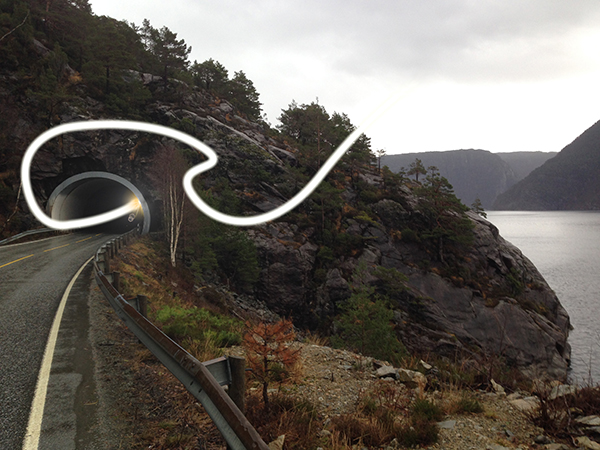Most tunnels rely on a complex web of power cables feeding electricity from distant energy sources to power light fixtures mounted in the ceiling. At the same time the tunnels are surrounded by daylight. A new pilot project at the Norwegian Public Roads Administration (NPRA) aims to challenge this rather counterintuitive way of lighting our tunnels by routing the outside sunlight into the tunnel.
This is to be done by way of photovoltaic panels mounted discretely at the tunnel entrance. Once the electricity has passed through inverters and cables the LED fixtures will essentially reverse the photovoltaic process and reemit the light down to the tunnel surfaces.
This pilot project is part of a collaboration between the R&D program Lower Energy Use in the Norwegian Road Administration (LEIV), and students at the Norwegian university of science and technology (NTNU). As part of my master thesis, I aim to design a photovoltaic plant to power a short tunnel in the western county of Rogaland. As of date, the tunnel is pitch black and a hazard for road users. The road is categorized as a Norwegian tourist road and is currently located outside the energy grid. This means that there are high costs associated with connecting the tunnel to grid electricity. This provided an opportunity for the NPRA to experiment with solar power.
Advantages
The price of solar power is declining. Deutsche Bank says that in January 2014 more than 19 countries are under grid parity. The world’s biggest markets, China, India, the U.S and Germany are expected to experience a second gold rush of photovoltaic investments. This will inevitably lead to a market for solar power also in Norway. It is therefore of importance for large contractors to gain some experience with the use of PV.
The actual cost of powering the tunnel will dramatically decrease, and the NPRA will have a large photovoltaic plant to use for research.
Testing of new concepts and technology
The tunnel, Kjøladalstunnelen, will be the location for the testing of several new technologies. The tunnel will have traffic controlled lighting, meaning that a radar will detect vehicles and activate the light sources as they approach the tunnel.
Guiding lights are also to be installed to see if it improves the visibility of cyclists and pedestrians.
In addition to normal lighting according to today’s standards, a new concept of illuminating short tunnels will be tested. The technique of using a band of light in the middle of the tunnel. This will reduce the energy consumption. Both the visual and economical effects of the reduced light will be studied.
The Photovoltaic plant
To meet the energy demand of the tunnel during the winter months the photovoltaic plant must be supplemented by for example a conventional gasoline generator. The cost of storing the PV energy in batteries for use in the low producing months of December and January would be much too high. Still, the PV plant will supply about 90% of the annual energy. 50 photovoltaic modules with a combined peak production of 13 kW are to be installed with a 24 unit battery storage. The 85 m2 of panels will deliver 5.75 MWh annually.
 Contact: Contact:Jørgen Wanvik (Student at NTNU, Trondheim) jorgentwanvik@gmail.com NPRA, Norway |







Follow us: